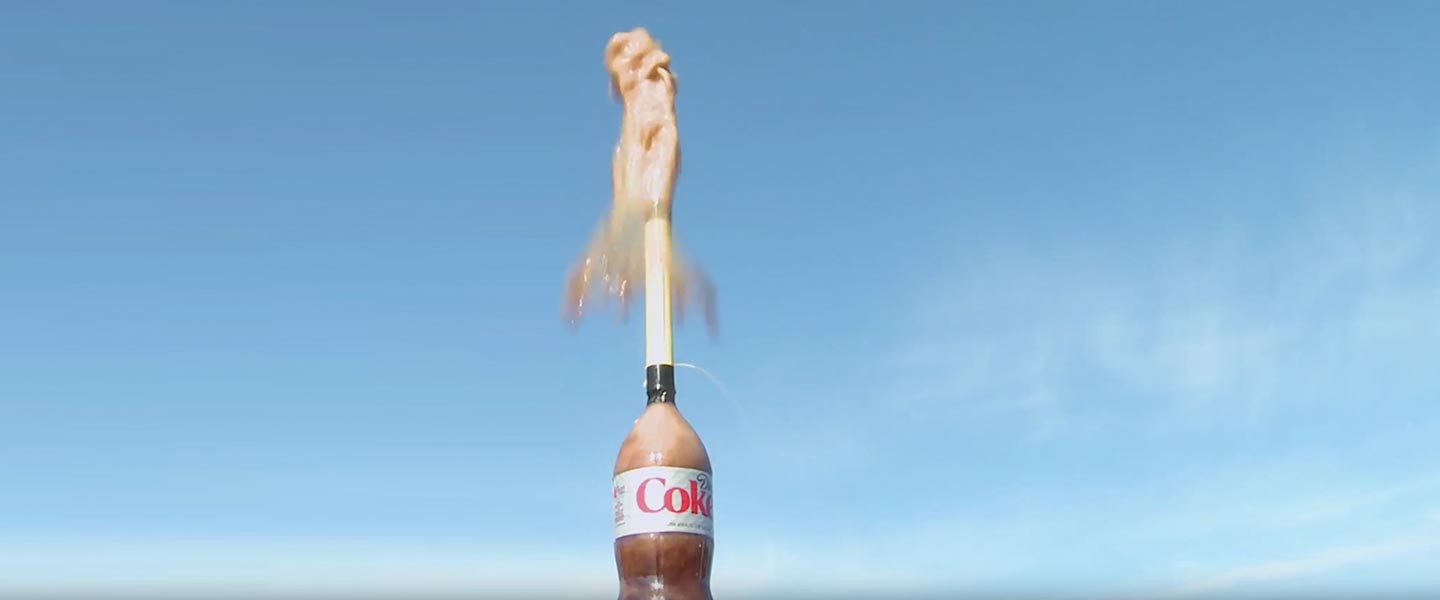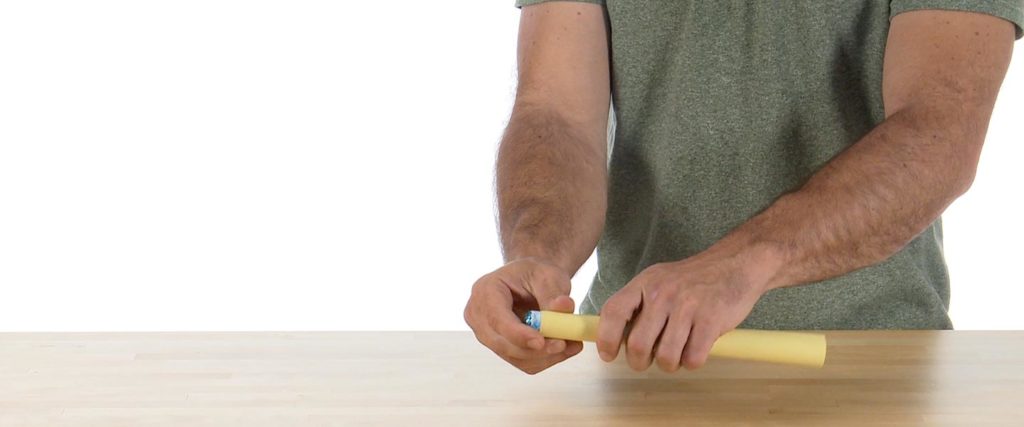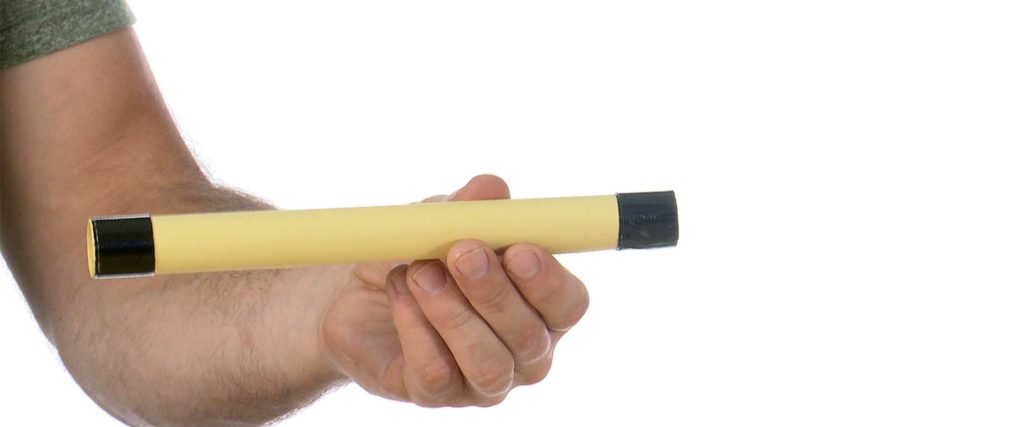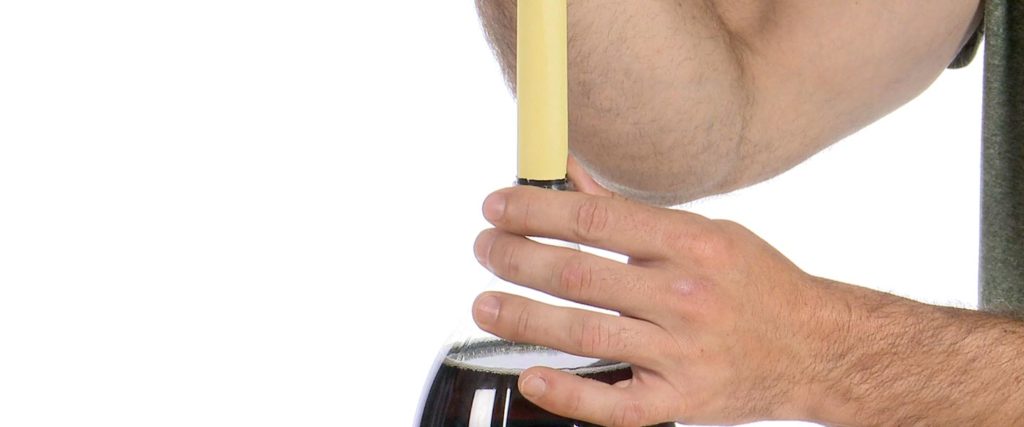Soda Can Shake-Up
In some circles, it’s considered bad manners to shake a can of soda just before giving it to a thirsty friend. The unexpected w-h-o-o-s-h of soda […]

Steve Spangler has been performing and explaining the Mentos Soda Geyser for years. So many geysers have erupted, in fact, that a device was designed to streamline the process. The Geyser Tube™ is, hands-down, the very best way to ignite a soda geyser that can erupt 15 feet (4.5 m) – or more – into the air. Of course, you may want to experience a soda eruption right away so here’s how to create a Homemade Geyser Tube using stuff you probably have at home.

Use the Mentos to roll the construction paper into a cylinder shape around the candy. You want the paper to be snug but also allow the candy to be be removed from it. Slide the candy out of the paper tube.

Tape (use electrical or duct) the ends of the tube to securely hold the shape and size of the rolled paper. Use tape at both ends and wrap it around the entire tube. You may want to tape the edge of the paper, too.(Leaving the Mentos in the tube may make taping easier. Just remove the candy for the next Step.)

Place one end of the paper tube into the mouth of a freshly-opened, 2-liter bottle of diet soda. Work at the bottom end of the tube to keep it straight and smooth along its length.

Hold the tube firmly in place with tape around the bottle opening.

Just above the tape by the opening, insert a toothpick straight through the paper. The toothpick needs to be centered in the tube and pierce both sides of the tube. Avoid making these two holes too large. The toothpick is the firing pin for the eruption.

GO OUTSIDE! Don’t cause eruptions indoors; either of soda or of tempers.
Drop 5-7 Mentos into the top opening of the tube. When you’re all set, slide out the toothpick and stand back! In only a few seconds, the geyser erupts in soda-foam fury and spray.
NOTE: A Geyser Tube includes special nozzles that can make a geyser erupt to 15 feet (4.5 m). The paper tube works just fine but the geyser rises to a few feet (m) above the bottle.
Soda pop is basically water, sugar (or artificial sweetener), flavoring, and preservatives. The thing that makes soda bubbly is carbon dioxide gas (CO2) which is pumped into the brew at the bottling plant. It takes tons of pressure and very low temperatures to do it, too. Until you open the bottle and pour a glass, the gas stays mostly suspended in the liquid and cannot expand to form bubbles, which a gas naturally does. If you shake the bottle and then open it, the gas is released from the protective hold of the water molecules. It escapes as a foaming whoosh! taking some of the liquid along with it. What other ways can you cause the gas to escape? Just drop something into a glass of soda and notice how bubbles immediately form on the surface of the object. For example, adding salt to soda causes it to foam because thousands of tiny bubbles form on the surface of each grain of salt.
Water molecules strongly attract each other, linking together to form a tight mesh around each bubble of CO2 in the soda. In order to form a new bubble, or to expand one already formed, water molecules have to be forced away from each other. It takes extra energy to break this “surface tension.” In other words, water “resists” the expansion of bubbles in the soda.
When you drop the Mentos into the soda, the gelatin and gum arabic from the dissolving candy surface break the surface tension around the dissolved gas. This disrupts the water mesh, so that it takes less work for the gas to expand and form new bubbles. Each Mentos candy has thousands of tiny micro-pits all over its surface, too. These tiny pits are called nucleation sites and they’re perfect places for CO2 bubbles to form. As soon as the Mentos hit the soda, bubbles form all over the surface of the candy.
Mentos candies are heavy for their size and sink to the bottom of the bottle. That’s a double-whammy for making a geyser erupt. With the candy on the bottom of the bottle and the gas being released, it pushes all of the liquid up and out of the bottle in an incredible gas and liquid blast. (You can see a similar effect when pasta is lowered into a pot of boiling water. The water will sometimes boil over because organic materials that leave the pasta disrupt the tight mesh of water molecules at the surface of the pot. This makes it easier for the water to bubble and foam over.)
When a scoop of ice cream is added to root beer, it foams over for basically the same reason. The surface tension of the root beer is lowered by ingredients and proteins in the ice cream. The CO2 bubbles rapidly expand and are easily released creating that beautiful foam on top of the float.
Why should you use diet soda? The simple answer is that it just works better than regular soda. Some people speculate that it has something to do with artificial sweeteners. More importantly, diet soda does not leave a sticky mess to have to clean up. Hey, that’s important for your clean up!
What’s the record for the biggest Mentos fountain? The official Spangler Science geyser was an 18-foot (5.5 m) blast that shot up and almost took out a half-million dollar, high definition TV camera. (You’ll find videos of some of our favorite eruptions online at www.SteveSpanglerScience.com.)
A Homemade Geyser Tube is a pretty cool activity but it’s not a science fair project. (The Mentos and Diet Soda eruption is a blast when you use a Homemade Geyser Tube! If you’re gathering data for a science fair project, however, you’ll get better, predictable, and more consistent eruption data and timing by using a Geyser Tube from Steve Spangler Science.) You create a science fair project by identifying and testing variables. A variable is something that might change the outcome. Consider some of the variable options you might test and write up for a science fair project. There are a variety of tests and measurements you can make using a Geyser Tube, Mentos, and soda. You might be wondering about which soda brand is best or how many Mentos to use for the best eruption or how the temperature of the soda might change things.
These are just a couple of ideas and you certainly aren’t limited to them! Come up with your own variable to test. Remember, you can change only one variable for each test while making sure that all the other factors in your test remain the same!
By now you know the formula for a Spangler Science lab:
Great Science + A Little Fun + Safe Lab Skills = Amazing Discoveries!
Safe lab skills include wearing safety goggles and that includes this lab. You need both eyes to gather the data and observe the results.
Steve Spangler has performed this demonstration thousands of times before audiences of all kinds and in all kinds of places. The reaction he gets is always the same: that’s amazing! Steve adds, “My thanks to Lee Marek, who originally shared the Mentos idea with me, and also to the hundreds of teachers and science enthusiasts who continue to share their funny geyser pictures, videos, and experiences. Keep ’em coming!”